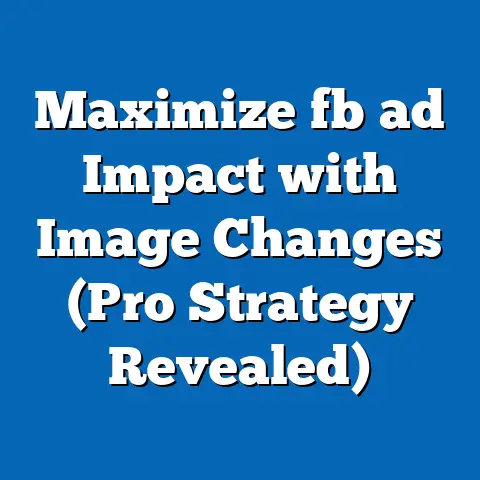Boost Ski Shop Sales with These Top Facebook Ads (Pro Tips)
Boost Ski Shop Sales with These Top Facebook Ads (Pro Tips)
Introduction: A Personal Journey into Ski Shop Marketing
A few winters ago, I found myself standing behind the counter of my family’s small ski shop in a quaint mountain town, watching the first snowflakes of the season drift past the window. My grandfather had started the business in the 1960s, catering to Baby Boomers eager to hit the slopes during the post-war outdoor recreation boom. Now, decades later, I was grappling with a new challenge: how to keep the shop thriving in an era dominated by e-commerce giants and shifting consumer behaviors across generations.
The societal implications of this shift are significant. Small businesses like mine are not just competing with big-box retailers but also navigating a digital landscape where generational preferences dictate marketing success. Understanding these dynamics—rooted in historical events, economic conditions, and technological advancements—can mean the difference between thriving and shuttering. Let’s dive into the generational characteristics that shape ski shop customer behavior, the historical context behind these trends, and actionable Facebook ad strategies to drive sales.
Section 1: Understanding Generational Dynamics in Ski Retail
Defining Generations and Their Characteristics
Generational studies provide a framework for understanding consumer behavior, though it’s crucial to avoid overgeneralization. Baby Boomers (born 1946–1964), Gen X (1965–1980), Millennials (1981–1996), and Gen Z (1997–2012) each bring distinct values, preferences, and purchasing habits to the table. These cohorts are shaped by the historical, economic, and technological contexts of their formative years.
Gen X, often dubbed the “latchkey generation,” came of age during economic uncertainty and the rise of dual-income households in the 1970s and 1980s. They value independence and practicality, often balancing family responsibilities with personal hobbies like skiing. As consumers, they tend to research products thoroughly before buying, blending traditional and digital shopping habits.
Millennials, shaped by the dot-com boom and the 2008 financial crisis, are digital natives who prioritize experiences over material goods. Many view skiing as a social activity or Instagram-worthy adventure, making them responsive to visually appealing, community-driven marketing. However, their purchasing power is often constrained by student debt and economic instability.
Gen Z, the youngest cohort, has grown up with smartphones and social media as constants. They value authenticity, sustainability, and instant gratification, often discovering ski gear through influencers or viral content. Their shorter attention spans demand creative, concise marketing strategies.
Historical Context and Societal Shifts
The ski industry itself has evolved alongside these generational shifts. In the 1960s and 1970s, skiing became a mainstream leisure activity for Boomers, fueled by increased disposable income and the development of modern resorts. The 1980s and 1990s saw Gen X embrace extreme sports, with snowboarding gaining popularity as a rebellious counterpoint to traditional skiing.
By the 2000s, Millennials faced economic challenges that reduced discretionary spending on sports like skiing, though social media began amplifying the sport’s visual appeal. Today, Gen Z’s focus on sustainability pushes ski shops to highlight eco-friendly gear, while their reliance on digital platforms makes online marketing non-negotiable. These historical trends underscore the need for ski shops to adapt to changing demographics through targeted digital strategies.
Societal Implications
The interplay of generational preferences has broader implications for the ski retail industry and local economies. Small ski shops, often located in resort towns, contribute to community identity and tourism revenue. However, their survival depends on bridging generational divides—catering to Boomers’ loyalty while capturing Gen Z’s fleeting attention. Failure to adapt risks ceding market share to online giants, diminishing the cultural fabric of mountain communities.
Moreover, the digital divide between generations affects how ski shops communicate value. While Boomers may still respond to in-store promotions or local newspaper ads, younger customers live on platforms like Facebook and Instagram. This necessitates a nuanced marketing approach that respects generational diversity while leveraging technology.
Section 2: Why Facebook Ads? A Data-Driven Choice for Ski Shops
The Power of Facebook’s Reach and Targeting
Facebook remains a dominant force in digital advertising, with over 2.9 billion monthly active users as of 2023, according to Statista. Its user base spans generations, making it an ideal platform for ski shops targeting diverse demographics. Unlike other platforms that skew heavily toward younger users (e.g., TikTok), Facebook offers access to Boomers, Gen X, Millennials, and Gen Z alike.
The platform’s advanced targeting capabilities are a game-changer for niche businesses. Ski shops can segment audiences by location (e.g., near ski resorts), interests (e.g., winter sports), behaviors (e.g., frequent travelers), and demographics (e.g., age or income level). This precision ensures ad dollars aren’t wasted on irrelevant audiences—a critical consideration for small businesses with limited budgets.
Cost-Effectiveness and Measurable Results
Facebook ads also offer a cost-effective alternative to traditional marketing. According to HubSpot, the average cost-per-click (CPC) for Facebook ads in 2023 is around $1.72, significantly lower than Google Ads’ average CPC of $2.69. For ski shops, this affordability allows experimentation with different ad formats and messages without breaking the bank.
Additionally, Facebook’s analytics tools provide real-time data on ad performance, from click-through rates (CTR) to conversion rates. This transparency enables ski shops to refine campaigns on the fly, ensuring maximum return on investment (ROI). As a small business owner, I found this data invaluable for understanding which ads resonated with specific generational segments.
Societal and Workplace Implications
The shift to digital advertising via platforms like Facebook reflects broader societal trends toward technology-driven commerce. For ski shops, mastering these tools isn’t just a marketing strategy; it’s a survival mechanism in an increasingly online marketplace. This transition also impacts workplace dynamics, as small businesses may need to hire or train staff with digital marketing expertise, bridging generational gaps in tech literacy.
Section 3: Pro Tips for Crafting Top-Performing Facebook Ads for Ski Shops
Tip 1: Segment Your Audience by Generation
Effective Facebook ads start with audience segmentation. Create separate ad sets for each generational cohort, tailoring messaging to their unique values and behaviors. For Boomers, emphasize nostalgia with images of classic ski gear and copy like, “Relive the golden days on the slopes with our premium equipment.”
For Gen X, focus on practicality and family-friendly offers, such as, “Gear up the whole family for winter fun—affordable bundles available.” Millennials respond to experiential marketing, so highlight group ski trips or scenic resort photos with captions like, “Make memories that last—book your ski adventure today.” Gen Z craves authenticity, so feature user-generated content or eco-friendly products with direct calls-to-action (CTAs) like, “Shop sustainable gear now!”
Tip 2: Leverage High-Quality Visuals and Video Content
Skiing is a visually stunning sport, and your ads should reflect that. Invest in high-quality images or short videos showcasing skiers in action, breathtaking mountain views, or close-ups of gear. According to Social Media Examiner, video ads on Facebook generate 12 times more shares than text or image ads, making them ideal for capturing attention.
For younger audiences like Millennials and Gen Z, consider carousel ads that showcase multiple products or behind-the-scenes footage of your shop. For older generations, static images with clear, bold text can convey trust and reliability. Always ensure visuals align with the emotional tone of your message—whether it’s adventure, nostalgia, or community.
Tip 3: Use Seasonal Timing and Urgency
The ski industry is inherently seasonal, so timing is everything. Launch ad campaigns ahead of peak winter months (November to February in the Northern Hemisphere), targeting early planners with promotions like pre-season discounts. Incorporate urgency in your copy with phrases like, “Limited stock—gear up before the first snowfall!” or “Early bird sale ends soon!”
Facebook’s scheduling tools allow you to run ads during specific times, such as weekends when families plan trips. Additionally, retargeting ads can remind past website visitors to complete purchases, capitalizing on holiday shopping spikes like Black Friday or Christmas.
Tip 4: Highlight Local Appeal and Community Connection
Small ski shops have a unique advantage over online giants: their local roots. Use Facebook ads to emphasize your connection to the community, such as sponsoring local ski events or offering in-store pickup for online orders. Geotargeting ensures ads reach customers near your shop or resort, increasing foot traffic.
For Boomers and Gen X, highlight your shop’s history or long-standing reputation with copy like, “Serving skiers since 1965—trust the experts.” For younger generations, showcase community engagement through partnerships with local influencers or environmental initiatives, reinforcing authenticity.
Tip 5: Offer Incentives and Track Conversions
Incentives like discounts, free shipping, or bundle deals can drive immediate sales. Create unique promo codes for each ad campaign to track which offers resonate with different generations. For instance, Boomers might appreciate a loyalty discount, while Gen Z responds to flash sales promoted via Stories ads.
Use Facebook Pixel to monitor conversions, such as online purchases or sign-ups for equipment rentals. This data helps optimize future campaigns, ensuring you allocate budget to the most effective strategies. In my own experience, offering a 10% first-purchase discount via Facebook ads increased online sales by 15% during the holiday season.
Tip 6: Test and Iterate Continuously
Digital marketing is not a “set it and forget it” endeavor. Run A/B tests with different ad creatives, CTAs, and audience segments to identify what works best. For example, test whether a humorous tone (“Ski like a pro, even if you’re not!”) outperforms a serious one (“Top-rated gear for serious skiers”) with Millennials.
Facebook’s split-testing feature simplifies this process, providing actionable insights within days. Continuously refine your approach based on performance metrics, adapting to seasonal trends and generational feedback. This iterative mindset transformed my shop’s ad strategy from guesswork to precision.
Section 4: Case Studies and Real-World Impact
Case Study 1: A Small Ski Shop’s Turnaround
Consider the example of “Mountain Edge Ski Shop” (a pseudonym for privacy), a family-owned business in Colorado. Facing declining foot traffic in 2019, the shop invested $500 in Facebook ads targeting local Millennials and Gen Z with video content of ski tutorials and gear demos. Within three months, online sales increased by 20%, and in-store visits rose by 10%, attributed to geotargeted ads promoting in-store events.
This success highlights the potential of tailored digital campaigns. By understanding their audience—younger skiers seeking affordable, trendy gear—Mountain Edge reversed a downward trend, preserving jobs and community ties.
Case Study 2: Bridging Generational Gaps
Another example comes from a Vermont ski shop that segmented ads for Boomers and Gen Z. For Boomers, they ran nostalgic campaigns featuring vintage ski imagery, resulting in a 25% uptick in premium gear sales. For Gen Z, they partnered with a local influencer for Instagram-linked Facebook ads, driving a 30% increase in entry-level snowboard purchases.
These outcomes underscore the importance of customization. By addressing generational nuances, the shop maximized engagement across age groups, demonstrating Facebook’s versatility as a marketing tool.
Societal Implications of Digital Success
These case studies reflect a broader trend: small businesses adopting digital tools can sustain local economies and cultural heritage. Ski shops are often economic anchors in mountain towns, supporting tourism and seasonal employment. Their ability to reach diverse generations through platforms like Facebook ensures relevance in a competitive market, with ripple effects on community vitality.
Section 5: Challenges and Nuances in Generational Marketing
Avoiding Stereotypes and Oversimplification
While generational frameworks are useful, they risk oversimplification. Not all Boomers are nostalgic, nor are all Gen Zers glued to TikTok. Individual preferences, socioeconomic status, and regional differences add layers of complexity to consumer behavior. Ski shops must balance generational targeting with personalized messaging, using Facebook’s dynamic ads to adapt content based on user interactions.
Digital Literacy Gaps
Generational differences in tech adoption pose challenges. While younger customers navigate online platforms effortlessly, older generations may struggle with e-commerce or ad-driven purchases. Offering hybrid solutions—like in-store consultations promoted via Facebook—can bridge this gap, ensuring inclusivity.
Economic Disparities
Economic conditions also vary across generations, affecting purchasing power. Millennials and Gen Z often face financial constraints, necessitating budget-friendly options in ads. Conversely, Boomers with disposable income may prioritize luxury gear. Ski shops must address these disparities through diverse product offerings and flexible pricing strategies in their campaigns.
Section 6: Forward-Looking Insights for Ski Shop Marketing
Emerging Trends in Digital Advertising
Looking ahead, ski shops must stay attuned to evolving digital trends. The rise of augmented reality (AR) on Facebook could allow customers to “try on” gear virtually, enhancing the shopping experience for tech-savvy generations. Additionally, voice search and AI-driven ad personalization may further refine targeting, though their adoption will vary by age group.
Sustainability as a Selling Point
Gen Z’s emphasis on sustainability will likely intensify, pushing ski shops to promote eco-friendly practices in ads. Highlighting recycled materials or carbon-neutral shipping can differentiate small businesses from competitors, appealing to socially conscious consumers.
Uncertainties and Adaptability
The future of digital marketing remains uncertain, with potential shifts in platform algorithms, privacy regulations, and user behavior. Ski shops must remain agile, diversifying across platforms (e.g., Instagram, TikTok) while maintaining a strong Facebook presence. Continuous learning and adaptation will be key to long-term success.
Conclusion: A Call to Action for Ski Retailers
My journey from a struggling ski shop owner to a digital marketing enthusiast taught me one critical lesson: understanding generational dynamics and leveraging tools like Facebook ads can transform small businesses. By segmenting audiences, crafting compelling visuals, and iterating based on data, ski shops can connect with Boomers, Gen X, Millennials, and Gen Z alike, driving sales while preserving community ties.
The societal stakes are high. Small ski shops embody the spirit of mountain towns, supporting local economies and cultural heritage. Their survival hinges on embracing digital strategies that respect generational diversity without losing the personal touch that defines them.
As we look to the future, uncertainties abound, from technological disruptions to economic shifts. Yet, with a commitment to adaptability and customer-centric marketing, ski retailers can thrive. Start small—launch your first Facebook ad campaign today, test your approach, and watch your slopeside business soar. The first snowfall waits for no one, and neither should your marketing strategy.






